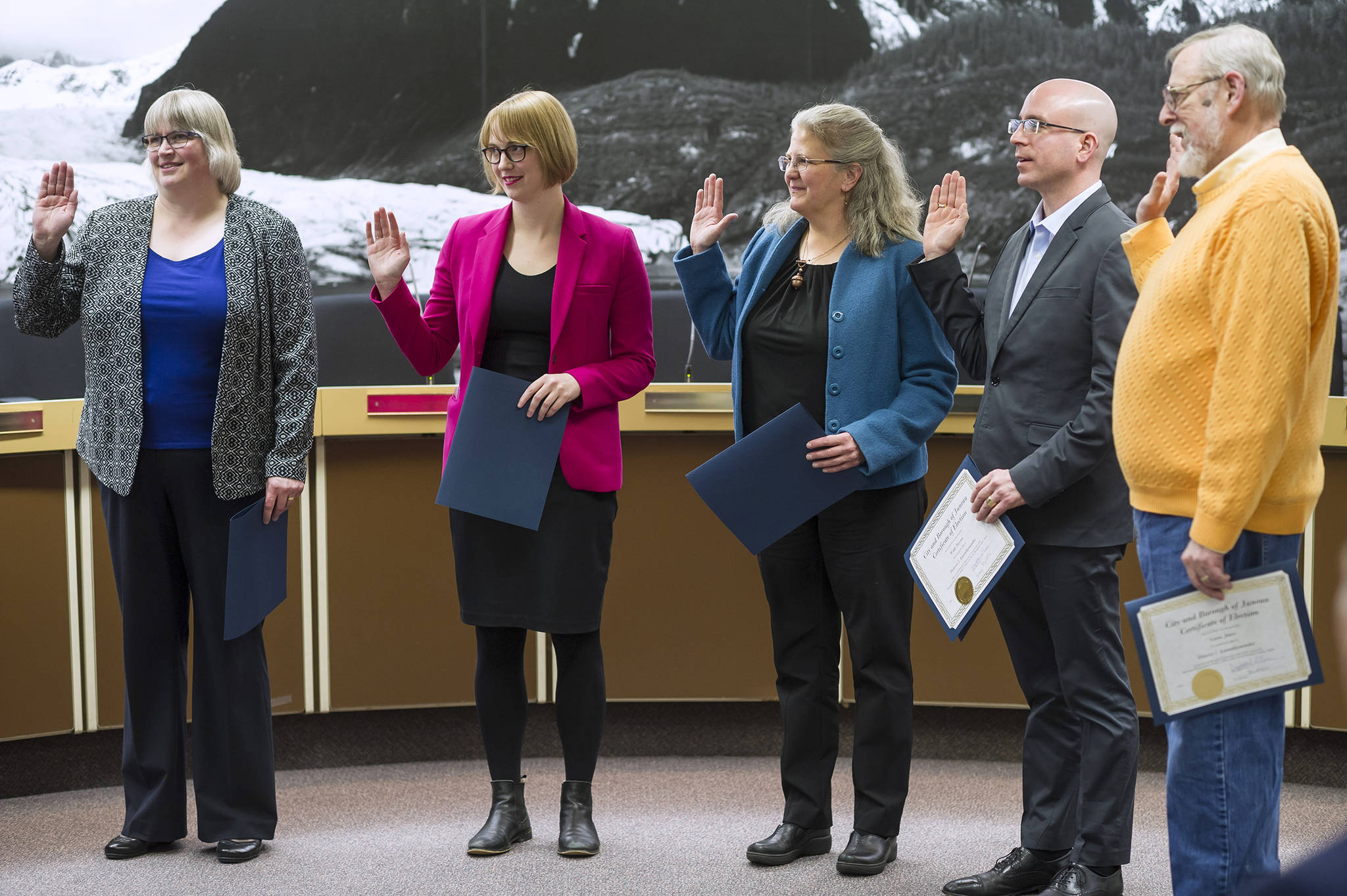City and Borough of Juneau’s annexation efforts are divisive now and were divisive when the Assembly voted to pursue annexation in January 2018.
Back then, a 5-4 vote approved filing an annexation petition with the Local Boundary Commission that would add lands near Juneau, including portions of Admiralty Island, to the CBJ.
At the time Assembly members Mary Becker, Maria Gladziszewski, Jerry Nankervis, Beth Weldon and Mayor Ken Koelsch voted for moving forward with annexation. Assembly members Norton Gregory, Loren Jones, Jesse Kiehl and Rob Edwardson voted against it.
[Small Rally protests annexation]
In the 18 months since then, the makeup of the Assembly has changed. Weldon is now mayor and Jones, Edwardson, Becker and Gladziszewski have been joined by Assembly members Carole Triem, Alicia Hughes-Skandijs, Michelle Bonnet Hale, and Wade Bryson.
City staff filed Friday a draft petition for informal review with Local Boundary Commission based on the resolution passed last year by the old Assembly. However, annexation is a long and public process, and the potential exists for the sitting Assembly to make its mark on how things proceed or even make a motion to repeal the resolution.
The Juneau Empire checked in with the first-term Assembly members to see where they stand on annexation.
Alicia Hughes-Skandijs: I was disappointed to see annexation efforts begin when the original vote passed. I don’t believe CBJ acted as a good neighbor, especially given the amount of feedback received from the public. There are different ways to look at the annexation, but I think the significance of the connection that the traditional caretakers have with this land means more to me than the original model borough boundaries. There will still be a further chance for the public to weigh in, and it will ultimately be up to the LBC to decide.
[Angoon opposes CBJ’s annexation efforts]
Michelle Bonnet Hale: Regarding a for or against response to your question, Assembly members provide such answers when we vote on matters, and our votes come after public discussion in Assembly meetings, Committee of the Whole meetings, etc. We have not had those discussions, nor have we had an opportunity to hear from the public on this question. It is premature to provide you my opinion on this matter before this process has occurred.
That said, as a former longtime state official (Director of the Water Division at DEC), I tend to support borough formation and boroughs such as the City and Borough of Juneau. In the rest of the country there are counties (except Louisiana, as I understand it, which has parishes which are similar to counties). The counties bridge an important gap between local and state control. In Alaska, we still have significant parts of the state that are unorganized and this is difficult from a state governance perspective. We are still young as a state, only 60 years old, and we still have some maturing to do. Part of that maturing is making sure we have the right organizational structures. I generally favor an organized borough structure rather than an unorganized one.
Carole Triem: Since I wasn’t on the Assembly for the 2018 vote, I can’t say how I would have voted then, but I do think that we need to take Angoon’s concerns seriously. If that means slowing down the process or amending our petition, I’m open to that. We should make sure we’re being good neighbors.
Wade Bryson: We have to take a serious, hard look at Angoon’s reasons for opposition and address those. No outcome is ever the best if one group is disregarded. I have a feeling that more discussion is going to take place before any action takes place. I’m in active information-gathering mode, so I’m able to make the best decision when the time comes.
What CBJ gains from annexation
There are a few different reasons CBJ is pursuing annexation.
It would better match Model Borough Boundaries that suggest what the borough-ization of the state could look like, it means being proactive instead of reacting to another borough or municipalities attempts to absorb the land, and projections show it means more money in CBJ coffers.
CBJ’s recently filed draft petition includes revenue and expenditure projections that outline the annexation’s expected impact.
In fiscal years 2020 and 2021 CBJ is projected to collect $222,300 in property taxes and $240,100 in sales tax from the annexed area, according to city documents. That’s a total of $462,400 is projected for each year.
Projections show CBJ expects to spend $84,000 in each of fiscal years 2020 and 2021 — $10,000 for finance and $74,000 for local contribution to education — on the annexed area.
The education expenditure increase is because the CBJ would be required to contribute more to education based on total property value increases, according to city documents. The estimated increase is based on a projected $28.14 million in additional property value.
The CBJ is not projecting increases in state or federal support related to annexation even though the annexed area includes federally owned land, according to the document.
That’s because the Federal Payment in Lieu of Taxes (PILT) program is population-capped, and Juneau is already at its limit.
“… Thus adding the additional federal lands in the annexation area will not have a material impact on the CBJ’s PILT revenues,” the document states. “The Federal government has not authorized payment for the Secure Rural Schools spending package for the next fiscal year, and appears unlikely to reauthorize in the future.”
Just six registered voters are reported in the proposed annexation areas, according to a document labeled Exhibit D, so annexation isn’t expected to cause a population surge that would entitle Juneau to more federal money.
• Contact reporter Ben Hohenstatt at (907)523-2243 or bhohenstatt@juneauempire.com. Follow him on Twitter at @BenHohenstatt.

